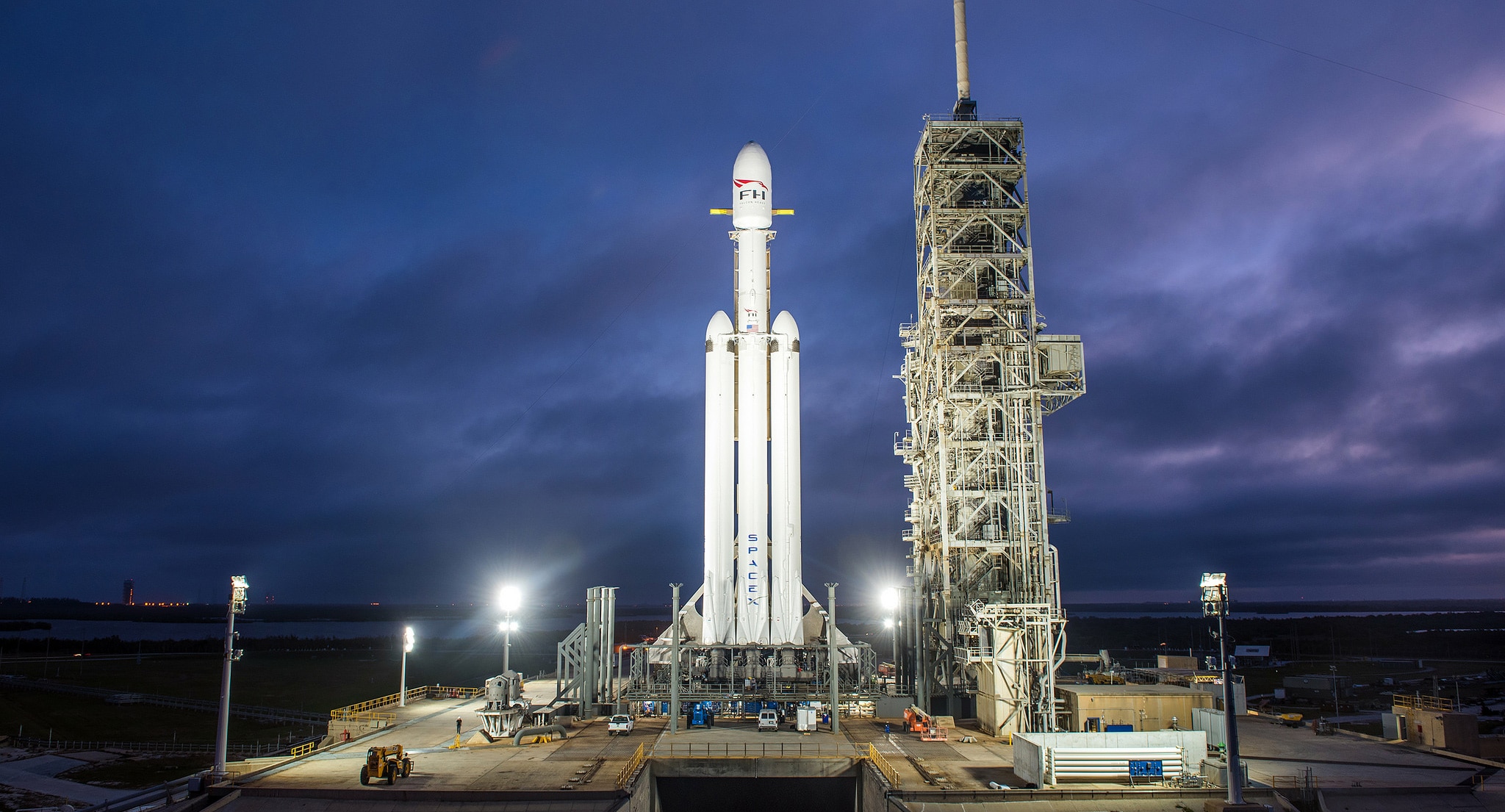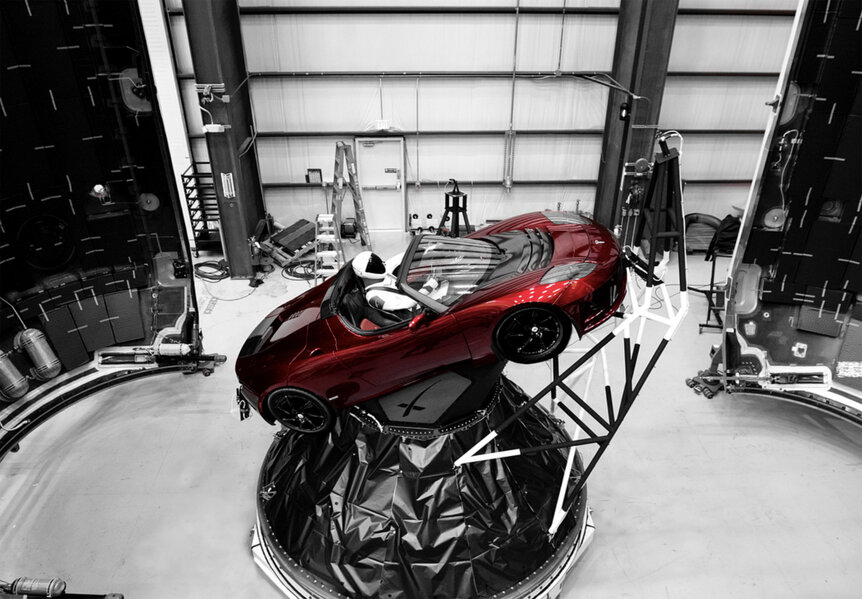Create a free profile to get unlimited access to exclusive videos, sweepstakes, and more!
Next Stop, the orbit of Mars: The Falcon Heavy is set to fly today

If all goes according to plan, the most powerful operational rocket since the Space Shuttle* will lift off from Florida today. At 15:45 Eastern time the SpaceX Falcon Heavy is scheduled to launch from Cape Canaveral [Updates (combined for less confusion): Upper level wind shear has pushed back the launch time several times now, from 13:30 to 14:20 to14:50 to 15:05 to 15:10 to 15:45. The launch window closes at 16:00, so this is likely the last (or penultimate) delay.]
If successful, it'll be a game-changer for space exploration. It will be able to loft over 60 tons of payload into low-Earth orbit (more than twice as much as the next-nearest competitor, the Delta IV, at just under 30 tons) and it will do so at a much cheaper price. Numbers vary depending on the launch details; SpaceX claims it can launch for $90 million (for a no-frills package), but typical costs will be closer to $160 million or so. Even then, that's really inexpensive for such a huge beast — a Delta IV launch is about twice that much, and NASA's planned Space Launch System (which admittedly has a larger payload capacity yet) has an estimated price tag of a billion (with a b) per launch.
So yeah, this is a big deal.
[Update (added 15:30 UTC): I've embedded the webcast livestream for the launch here. It should go live a little while before the scheduled launch time, so check back often!]
What should you expect for the launch?
In my opinion, most likely, a scrub. Seriously; this launch is important, and I expect any issues at all — weather, engineering, a wayward boat, a bird sitting on the nose cone — will cause a delay.
But the weather at the moment looks good, and I've heard of no problems. So assuming the countdown gets to zero and there are no issues …
First, here's a video put together by SpaceX showing the highlights:
So what's what here? You've probably seen the launches of the Falcon 9, the SpaceX workhorse rocket. The Falcon Heavy is essentially three such first-stage boosters strapped together. At launch, the three will work in unison, with all 27 Merlin engines firing.
About two minutes later, the two side boosters' engines will cut off, and the boosters will separate from the central one. They will then flip around, kill their forward velocity with some of their remaining fuel, then come back to land at Kennedy Space Center.
The central booster will continue to burn for a short time. Then the second stage will separate from the central booster, fire its engines, and head on and up. The first stage central booster will then return to Earth, touching down out in the Atlantic on the floating platform named Of Course I Still Love You.
While that's happening, the payload fairing (the clam-shell protective casing around the payload) will be ejected from the second stage. The second stage will continue burning until it and the payload reach low-Earth orbit. It will then coast for several hours in what's called a parking orbit, while engineers on the ground check everything out and make sure all's well. Once it checks out, the engine will be re-ignited to start the trans-Mars injection burn — literally, putting the whole thing on a trajectory that will take it away from Earth and the Sun as far out as Mars.
Once that burn is complete, the payload will separate from the second stage, and both will become satellites of the Sun.
And that payload … I've written about it before. It's SpaceX CEO Elon Musk's own car, a cherry-red Tesla Roadster. He recently announced it will also have a passenger of sorts: a dummy (dubbed "Starman") wearing the company's space suit, designed for future astronauts who will eventually ride SpaceX rockets into orbit and beyond.
I'll note reactions to the payload are … mixed. Some hate it, some love it. To properly test the rocket there needs to be something in there, and in many cases a dummy mass or a heavy weight is used. But of course that would never fly (haha) with Musk, who is a showman.
Mind you, a first flight is an incredibly complex and difficult mission, so adding several more layers of complexity by putting an actual scientific satellite into the payload is not a great idea. Better to keep things as simple as possible. Putting a car in there was a "sentimental" choice by Musk; he likes the idea of his Roadster cruising the space between Earth and Mars. As a PR move it has clearly worked, generating headlines for weeks.
As an aside, the odds of the car actually hitting Mars are incredibly low. In his Planetary Society post, Jason Davis talks about this, and includes this explainer video by engineer Max Fagin:
All the PR and payload aside, this is a critically important launch. The Falcon Heavy could very well revolutionize access to space, making it more reliable and far less expensive. Musk has already said the Falcon 9 and Heavy will both make way for the next-generation vehicle, the BFR (for Big Falcon Rocket, more or less), which he hopes will take people to Mars.
And in the meantime Blue Origin has already announced plans for much larger rockets, including the orbital New Glenn, and the New Armstrong that will hopefully be capable of sending payloads to the Moon.
But. First things first. The Falcon Heavy launch will be streamed on the SpaceX site. If everything goes nominally it'll be quite a sight; there will be cameras on the boosters as well as mounted in the Roadster itself.
So, to all the folks at SpaceX: May the wind be at your back. Ad Ares.
[N.B. It occurred to me after this article was published that the original title ("Next Stop, Mars: The Falcon Heavy Is Set To Fly Today") could be interpreted as the goal being orbit around Mars; instead I meant it to literally mean the payload will get as far from the Sun as the orbit of Mars. We’ve updated the title; my apologies for any confusion.]
* For some reason, I had in my head that the Falcon Heavy was more powerful than the Space Shuttle. However, looking just at thrust at takeoff, the Falcon Heavy generates 22.8 megaNewtons of thrust while the Shuttle had 30.25. I originally wrote this rocket was the most powerful since the Saturn V, but that is not correct.



























